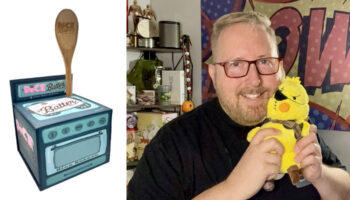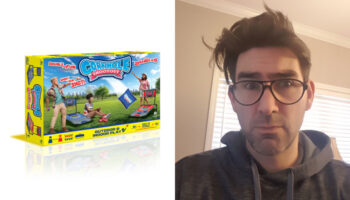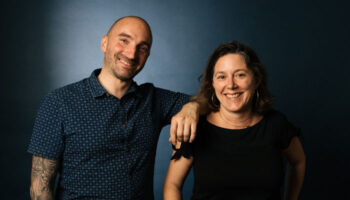Big Potato’s Ed Naujokas on how automatic writing and spirit slates helped bring Ghosts Can’t Draw to life

Ed, it’s great to catch up. Before we dive into one of Big Potato’s latest games, what set you on a path into game development and Big Potato? Was it always on the cards?
Hi Billy. It feels like it’s been quite a long path to get here, so I’ll try and keep it brief!
After doing a Degree in Fine Art there was lots of searching for what I wanted to do – and too many years working in retail. I decided I needed to do something else and board games had always been an interest of mine. I’d also toyed with the idea of making my own. I came across the Games Design MA at LCC and it sounded perfect. It was the only course I could find that wasn’t just digital games, but also covered physical games like tabletop, RPGs and escape rooms.
It was an amazing course and my final project was a ‘choose your own adventure dexterity’ game. After graduating, I entered it into the UK Games Expo Designer/Publisher speed dating event and managed to pitch it to a bunch of publishers – one of which was Big Potato.
Ah! Did the pitch go well?
Yes! They signed it and it ended up as What Next? I was quite involved in the development of the game over a couple of years with James Vaughan at Big Potato, and I also pitched a couple of other games at the same time. After What Next? was released, James offered me a role as a game designer at Big Potato and I jumped at it!

Terrific! Now, let’s talk about your new game, Ghosts Can’t Draw. I love the look of this! For anyone new to it, what’s the premise?
So all the players are gathered around a large drawing board in the middle of the table. Everyone gets given a secret card – most of them will be a ‘Paranormal Investigator’, but one will be a ‘Ghost’. The ‘Ghost’ will have a object written on their card that they need to draw and get the other players to guess.
Then you place the ‘ghost doodler’ – think planchette with a pen in the middle! – on the board. Everyone places their fingers on it and closes their eyes. The ‘Ghost’ then moves the doodler around trying to draw their secret word. The rest of the players then guess who the ghost was and what they drew. Think a seance meets Pictionary! It’s also got a fun ‘spooky timer’ website with a Vincent Price style narrator guiding you through the rounds.

Brilliant. Where did the idea for this spark from?
The original spark came from an article I read on Shut Up and Sit Down by Ava Foxfort. It was all about games where you close your eyes and the ‘magic’ that comes from that. It got me thinking about what interesting things could happen in a game whilst people have their eyes closed.
Nice. I’ll pop a link to that article here so folks can check it out.
Great! Two other big inspirations for it were the surrealist game of automatic writing, as well as the spirit slates trick mediums would use to communicate with ghosts. There was also a brilliant exhibition at the Wellcome Collection called ‘Smoke and Mirrors’ about the psychology of magic. That fed into this too.
Did the game morph much during development?
Loads! The very first version of the game was back in 2019. In version one, everyone closes their eyes and the ghost player draws with their eyes closed, using their non dominant hand, in a single line, on a chalk board… It created this spooky scratching noise and eerie scrawl when everyone opens their eyes.
It sounds interesting! What made that version fall down?
It was a fun experience, but not much of a game. I didn’t want it to be about lying about being the ghost and trying to figure it out… I wanted it to focus more on the drawing part and creating a spooky experience.
So, after numerous versions – including a murder mystery where players were trying to guess the classic who, where and how the ghost was murdered – the game slowly developed into using a planchette… That’s when it really started taking shape. Although the planchette itself went through about 10 different versions!

It’s amazing how many routes a game can go down before you crack it.
For such a simple game, this went through a lot of back and forth! There was also a version with everyone writing guesses and mixing them up, but it required too much lying from the ‘Ghost’. I wanted to really focus on the fun mystery when everyone has their eyes closed, not the deception part.
There’s perhaps a perception that drawing games are a tough nut to crack, what with there being some big players in that space. Did the fact that this is an area of games dominated by a few long-standing favourites shape any part of the process or decision-making around this one?
Drawing games are an interesting one, most of them tend to reward players who are good at drawing and can be very off putting to people who maybe aren’t as confident in their abilities. It’s very similar to trivia games… If someone is really good at trivia, they just dominate the game and beat everyone. That’s no fun for the other players.
I think the thing that shaped the process of making the game was the idea of ‘you don’t have to be good at drawing to enjoy this game – and you won’t be made to feel bad’. Big Potato’s other drawing game – Scrawl – felt like a good benchmark for an accessible drawing game. It’s actually much funnier when someone isn’t very good at drawing, and it doesn’t make anyone feel bad for not being very good at drawing.

With Ghosts Can’t Draw, because of the restrictions in the game of eyes closed and pushing this ‘ghost doodler’ around, there’s the nice moment when the drawing is revealed. Everyone kind of expects it to be bad, so when it is ‘bad’ it’s funny and everyone says: “What is that?!’” But if its good, it’s really impressive.
A win-win!
Exactly. There’s also the nice moment when the words of what might have been drawn are revealed. All of a sudden, a random unintelligible squiggle can become a shark or a toaster… And that makes the guessers feel clever because they can finally see what the drawing is.
Great answer. And what helps you have ideas for games?
There are obviously some amazing games and designers out there that can inspire new ideas. Quite often I’ll see a box cover for a game and think it’s one thing, then turn the box around and it’s not what I thought at all… But that means the thing I thought it was is up for grabs! That always feels like a free idea!
Ha!
I think it’s also important to look at things outside of games. Films, TV and books are all great sources for sparking ideas too. For example, one game idea I’m working on now was inspired after watching Oppenheimer – but the games isn’t as scary as it sounds! I’m also a fan of going to museums and exhibitions for inspiration too.
We’ll have to come back and chat about the Oppenheimer-inspired game if and when it arrives on shelves! Last question! What do you feel is Big Potato’s most underrated game? We can show it some love here!
One game that I have a lot of love for but didn’t quite hit the mark was Good Face Bad Face. It felt like a nice balance of super simple, with a fair bit of depth and some really nice player interactions.

Good pick. Thanks again Ed.
–
To stay in the loop with the latest news, interviews and features from the world of toy and game design, sign up to our weekly newsletter here
























